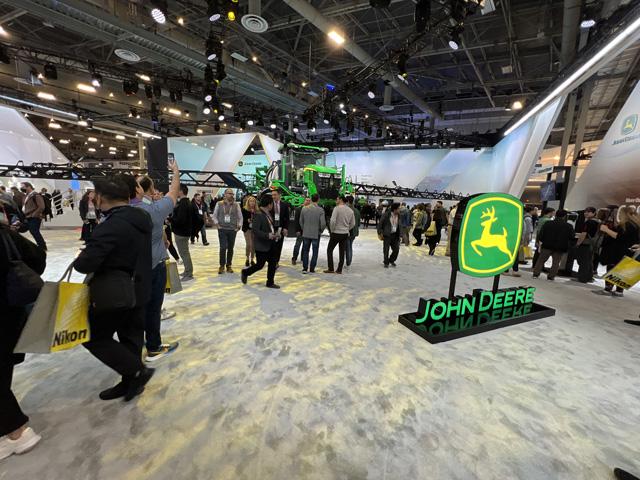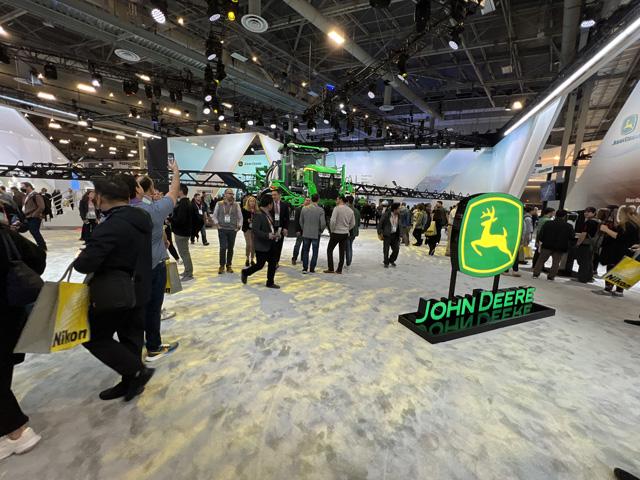MachineryLink
Deere Works to Use Its Camera Technologies to Read Stress Markers in Plants
LAS VEGAS, Nev. (DTN) -- John Deere offered at the CES, once known as the Consumer Electronics Show, opportunities to meet with executives and experts in areas of interest to the ever increasingly tech-focused manufacturer.
In three interviews with DTN, John Deere experts talked about a variety of the company's initiatives, including ExactShot, a system that applies starter fertilizer only to the seed, about its plans to greatly expand its See & Spray franchise and its approach to electrification.
Here are some excerpts from those interviews:
**
Jorge Heraud, VP Automation and Autonomy at John Deere, former CEO Blue River Technology purchased by Deere in 2017.
-- Search For More See & Spray Applications:
"See & Spray Ultimate is saving two-thirds of the herbicides (farmers) would otherwise use. But for all the excitement, this is just the start of the road. We're going to begin with being able to do even more -- with fungicides, insecticides, plant growth regulators, maybe even nutrients."
-- Plants Will Tell Farmers When They Are Under Attack:
P[L1] D[0x0] M[300x250] OOP[F] ADUNIT[] T[]
"Deere made (last September a $16 million) investment in a company called InnerPlant. InnerPlant is a startup company with a technology that allows plant leaves under certain stresses to emit a protein to fluoresce (shine or glow brightly), to signal when they are having trouble ... that means that when it's shined with a certain light (its) response is shining back with a different light, very faint, not noticeable with the human eye. But it's enough for our cameras to be able to detect it. And we think that if things go right, that technology is going to take off and our machine(s) are going to be able to see (those plants) that are a little bit different, that are fluorescing and saying, 'Hey, this plant is telling us that it is under fungal attack.' It is super insightful. Because when you see a yellow leaf or a yellow plant, you don't know if it's water, if it's because of insects, a fungus (or lack of) nitrogen. A lot of things can make a plant look like that. But this technology is very specific. It can tell you if it's an insect, or if it's in nutrient stress, or if it's being attacked by a disease. So, with that, you'll be able to target and apply (to) the plant what it needs."
Editor's Note: InnerPlant is developing a variety of genetically engineered living sensor plants that signal when they're stressed. When crops experience fungal pressure, are attacked by pests, lack nutrients, or are thirsty, the leaves fluoresce in different colors, serving as an early warning system for growers. The startup is currently focusing on soy, corn and cotton. For more info, see www.innerplant.com.
**
Lee Johnson, engineering manager crop care architecture and technology development, John Deere.
-- Ins/Outs of Deere's New ExactShot Starter Fertilizer Technology:
"ExactShot exact shot builds on Deere's ExactEmerge planter technology which feeds singulated seeds into a brush belt. It very accurately controls the seed path all the way down to its release point. That's been super critical in taking precision placement to the next level. And at speeds up to 10 miles an hour. Meanwhile, our ExactApply technology on our sprayers (has) the ability to accurately pulse small doses of liquids. That's enabled See & Spray.
"(With ExactShot) we've put the (those) actuation pieces close to the seed trench for maximum precision. As seeds are singulated, handed off into the brush belt, they pass by a reflective seed sensor that verifies there's a seed. It also registers exactly where the seed is in the brush. We know exactly where the release point is. And so, if you're planting corn at 10 miles per hour, you're shooting seeds out at 30 seeds per second. The algorithm knows ground speed, it knows when the seed is coming out, and we just simply synchronized that spray to hit that seed only. We've found in our field trials that we can reduce (use of) starter fertilizer by 60% (while maintaining) the same plant health and same yield."
-- The Production Effect:
"(Deere) believes (ExactShot) is a paradigm shift. It's a paradigm shift, like See & Spray. You're not spraying continuously. Another point is use of starter. When we ask customers who don't use starter fertilizer (why), it is almost always the productivity hit to planting, of messing with starter fertilizer (while trying to maintain a timely planting pace). He may be stopping two or three times as often (with starter). Well, 60%, less starter fertilizer means fewer stops."
-- Availability of ExactShot:
"This spring, (ExactShot) will have limited availability to some paying customers (Midwest). That will be as a retrofit kit. As we continue to do more testing in more conditions, more environments across more growing regions, (eventually there will be) a factory installed kit."
**
Joel Dawson, manager of precision and ag marketing for North America, John Deere.
-- Approach to Electrification:
"I'm going to frame up electrification into a couple of buckets. First, there are battery electric vehicles that propel themselves and operate with full electrification. Second, and more applicable for (agriculture) is electric offboarding, or the generation of electric power (from a diesel engine) to move it back to implements behind a tractor, (for an) ExactEmerge planter or perhaps powering axles on an implement to assist it with tractive power (Deere is working in those areas). When you look at large ag applications, operating that (large) machine solely on batteries, that is not something (Deere is) focused on. We're not developing big tractors with battery electric propulsion. Now smaller machines, say 165ish horsepower or less, or turf and utility applications, absolutely we're focused on it. And we have some of those machines that are in development."
Dan Miller can be reached at dan.miller@dtn.com
Follow him on Twitter @DMillerPF
(c) Copyright 2023 DTN, LLC. All rights reserved.






Comments
To comment, please Log In or Join our Community .